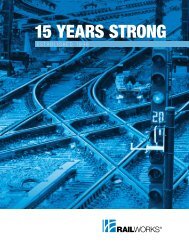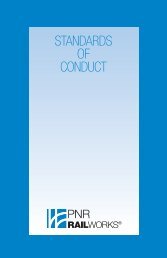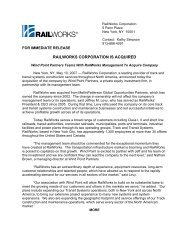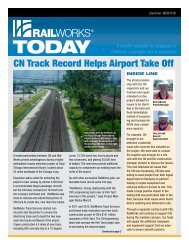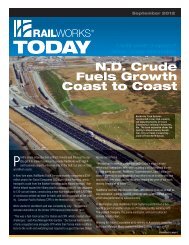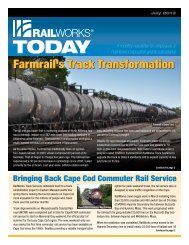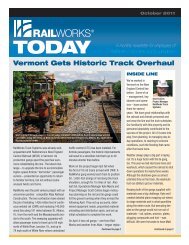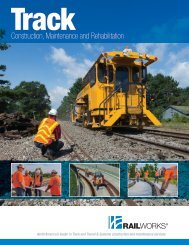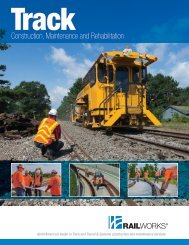Despite Growth, Firms Worry - Railworks Corporation
Despite Growth, Firms Worry - Railworks Corporation
Despite Growth, Firms Worry - Railworks Corporation
Create successful ePaper yourself
Turn your PDF publications into a flip-book with our unique Google optimized e-Paper software.
THE TOP 400 CONTRACTORS<br />
OVERVIEW<br />
the Patient Protection and Affordable Care Act and<br />
the uncertainty of its effect on health-care providers.<br />
However, contractors of all types, regardless of what<br />
market they serve, have their own concerns about the<br />
new health-care law.<br />
Many contractors worry about the potential costs<br />
and mandates under the new law. “Costs associated<br />
with the required health-care coverage will have to be<br />
addressed in the next 12 months,” says Joel Stone,<br />
CEO of SpawGlass.<br />
SpawGlass is one of many major contractors that<br />
are concerned about the impact of the federal healthcare<br />
law. “We work both union and non-union, and<br />
the law requires us to provide specific levels of coverage<br />
for non-union employees or face penalties,” says<br />
Dunn of JE Dunn. He worries that expenses incurred<br />
under the law will hurt many contractors.<br />
“But there seems to be new or added levels of record-keeping<br />
and compliance requirements,” Levy<br />
says. Contractors are working hard to do more with<br />
less, squeezing out efficiencies in their processes and<br />
investing in technology and equipment to make themselves<br />
more competitive in a tough, hard-bid market,<br />
he observes. “We try to chase costs down, only to have<br />
federal regulations require us to hire a new wave of<br />
compliance officers. In a competitive market, you can’t<br />
just pass these costs to the customer,” Levy says.<br />
The construction industry sees positive signs and<br />
uncertainties. Contractors continue to plan for the<br />
turnaround that is bound to come, seeking new<br />
markets and services. But some contractors are looking<br />
a little further into the future than others. On April 16,<br />
Bechtel announced it had become one of the investors<br />
and collaborative partners with Planetary Resources,<br />
a group researching the feasibility of mining asteroids.<br />
“This is something that is probably 30 years away from<br />
being a market, but it is something we are looking at<br />
for the future,” says Dudley. n<br />
Oil & Gas | By Gary J. Tulacz<br />
Taking the Long View on LNG<br />
The U.S. construction industry is<br />
profiting from the shale-gas<br />
production boom of the past few<br />
years, and its effects go well beyond<br />
the Lower 48 and Alaska. Bill Dudley,<br />
president of Bechtel (No. 1), says<br />
the U.S. gas boom also is influencing<br />
the worldwide construction market.<br />
For example, natural-gas prices in<br />
the U.S. are about 75% lower than<br />
markets in Japan and India. The<br />
demand for cheaper U.S. gas means<br />
the market for LNG import terminals,<br />
particularly in Asia, will surge. For<br />
example, GAIL, India’s state-owned<br />
gas company, said in January it will<br />
double the size of its Dabhol LNG<br />
import terminal.<br />
U.S.-based fracking also may<br />
affect construction in Canada.<br />
Canadian gas producers may be<br />
rethinking gas export plans, focusing<br />
on the Asian and European markets<br />
as export destinations. “Instead of<br />
seeing north-south pipelines in<br />
Canada, you may be seeing them<br />
going east or west,” Dudley says.<br />
Low prices in the U.S. already are<br />
scaring many other gas-producing<br />
regions. In February 2012, Russia’s<br />
Gazprom was pressured to lower its<br />
prices by 10% to European<br />
customers, who have the option of<br />
importing inexpensive U.S. coal and<br />
LNG. In fact, European coal imports<br />
from the U.S. have risen 250% since<br />
2005.<br />
The Middle East is starting to<br />
focus more on natural resources<br />
other than oil and gas, which means<br />
more projects in mining and<br />
production facilities, particularly<br />
aluminum smelters. For example,<br />
Ma’aden Saudi Arabian Mining Co. is<br />
building a $10.8-billion plant in Saudi<br />
Arabia, while Emirates Aluminum is<br />
spending $4.5 billion to expand its<br />
Abu Dhabi plant. n<br />
How to Read the Tables<br />
Companies are ranked by construction<br />
revenue in 2012 in ($) millions. Those<br />
with subsidiaries (†) are listed by<br />
company rank, which may be found on<br />
the ENR website at www.enr.com. <strong>Firms</strong><br />
not ranked last year are designated as **.<br />
Some markets may not add up to 100%<br />
due to omission of the “other” miscellaneous<br />
market category. NA= “not<br />
available.”<br />
Figures include prime construction<br />
contracts, shares of joint ventures,<br />
subcontracts, the construction portion of<br />
design-construct contracts and construction<br />
management-at-risk contracts when<br />
the firm’s risks are similar to those of a<br />
general contractor. Figures also include<br />
the value of installed equipment when a<br />
firm has prime responsibility for specifying<br />
and procuring it within the scope of its<br />
construction contract.<br />
General Building includes commercial<br />
buildings, offices, stores, educational<br />
facilities, government buildings, hospitals,<br />
medical facilities, hotels, apartments,<br />
housing, etc.<br />
Manufacturing includes auto assembly,<br />
electronic assembly, textile plants, etc.<br />
Power includes thermal and hydroelectric<br />
power plants, waste-to-energy plants,<br />
transmission lines, substations, cogeneration<br />
plants, etc.<br />
Water Supply includes dams, reservoirs,<br />
transmission pipelines, distribution mains,<br />
irrigation canals, desalination and<br />
potability treatment plants, pumping<br />
stations, etc.<br />
Sewerage / Solid Waste includes<br />
sanitary and storm sewers, treatment<br />
plants, pumping plants, incinerators,<br />
industrial waste facilities, etc.<br />
Industrial Process includes pulp<br />
and paper mills, steel mills, non-ferrous<br />
metal refineries, pharmaceutical plants,<br />
chemical plants, food and other<br />
processing plants, etc.<br />
Petroleum includes refineries,<br />
petrochemical plants, offshore facilities,<br />
pipelines, etc.<br />
Transportation includes airports,<br />
bridges, roads, canals, locks, dredging,<br />
marine facilities, piers, railroads,<br />
tunnels, etc.<br />
Hazardous Waste includes chemical<br />
and nuclear waste treatment, asbestos<br />
and lead abatement, etc.<br />
Telecommunications includes<br />
transmission lines and cabling, towers and<br />
antennae, data centers and web hotels, etc.<br />
PHOTO COURTESY OF BECHTEL<br />
enr.com May 20, 2013 ENR 12



